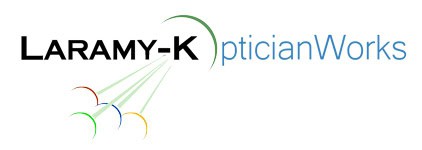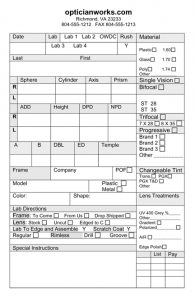Back to: 7: Finishing: The Optician’s Edge
Always remember that your relationship with the lab is a two-way street, requiring professional courtesy on both parts so that both your businesses can flourish. Be nice. Treat lab personnel as you wish to be treated.
Your lab will have expectations of your responsibilities to them. The optician’s practice maintains a good relationship with the lab by providing all the necessary information when submitting jobs. Failing to do so is a waste of someone else’s time. If you have all the necessary information at hand when submitting orders to the lab, you can avoid mistakes and delays. The lab will expect you to have a solid understanding of all the material covered in this lesson. Errors and misunderstandings resulting from ignorance are costly and avoidable.
See also: OpticianWorks.com Course 6 Sales, Business Management & Vision Care Plans for more about remakes.
Most labs will be happy to provide you with the order pads they would prefer that you use. That way you can read information to them from the same form they use to record it. This is helpful, especially when you are just getting started.
The first few calls to a lab can be a little scary. Save the lab, yourself and your patient a few headaches by being prepared and you will be proficient at placing orders in no time.
When calling in an order things do get a little more complicated.
Be sure you have ALL the information outlined below BEFORE you pick up the phone.
A typical order may sound very much like this: “Hello, this is John calling from 521487. I need to place an order. This will be for patient Ronald Allen. These will be uncut. He is going into an Integrity Rogue progressive in 1.60 with the ICE Clear AR. His Rx is right -1.00 -1.00 axis 89, his left is a -1.00 -1.50 axis 87 with an add of 1.50. His PD is 32/31 and the height is 19 OU. He is wearing a metal, full-eyewire, Justin Baliko 2219, with an A of 54, a B of 30, a DBL of 19 and an ED of 56.”
The CSR will read all that back to you and the order will begin.
Work may be sent to the lab by fax. (Yes even in 2024 some things still get faxed.) Faxing may be the way you or the lab prefers to process work orders. Faxing has some advantages over telephone ordering. It does not tie up a customer service representative, and the fax provides a record of what you sent, should any discrepancy arise. A fax will go through even when the lab is closed, to be picked up the following day. However, if information is missing from the fax order, the lab will need to call you back for verification or clarification, which can cause delays on the job being processed.
The gal said, “I’m sorry John, but I can’t fax that to you because of where we live.” I said, “Huh, where do you live?” She said, “In 2024 John, 2024.”
More and more labs and stores are making web-based online order entry possible. This is because the online ordering systems are equipped with a variety of features that make orders more accurate and the overall order transmission process more efficient – both for you and your lab.
Another big benefit of online ordering is that orders submitted on the web go directly into the lab’s system for processing, skipping ahead of those orders that are phoned or faxed and require manual entry.
If you have the ability to remotely trace a frame, you can send the trace files with your online orders. (Some labs even provide the hardware required to send frame tracings directly to the lab.) Having the ability to remotely trace a frame shape eliminates the need for a patient to be without their glasses while the lenses are made. More on this coming up.
Lab Order Forms:
This is a variation of the actual lab order form I used for over ten years. I filled literally thousands of jobs with it. It was created using tables in Microsoft Word. A variation of it could easily be duplicated by someone with time and knowledge of Word. The lab order form is a way of communicating. It is a link between you, your customer, the lab, and, perhaps most importantly, your coworkers.
Yes, your coworkers! The more complete this, or an online order is, the easier it is to do a remake or handle a warranty issue.
Let’s say customer should lose a pair of glasses and want a new pair “just like the ones I lost”. If your job order is complete, you can fill that order in a matter of minutes. This is a great piece of customer service especially for the customer that is away on vacation. To be quite frank, you and your store look quite stupid if you don’t have enough information to repeat a job you filled!
Even if you work in a 100% paperless office and use Internet ordering, you need to know these terms and concepts! They will still be there as entry points.
Taking it box-by-box:
Header: Include all information necessary for a lab to contact your office: company name, telephone number, address, fax number and website address. Do not assume the same person will always be dealing with your work orders. Lab people also have vacations, sick days and holidays.
Date: Always date the job order form with the date the order went into the lab. If you work on Saturday, but your order will be submitted on Monday, date the ticket for Monday. This assures that you are giving the lab and the customer a realistic period for the job to return.
Lab: You may use several different labs because of insurance and lens preferences. Indicate which lab has the job, so you will know where it is.
“Rush:” A customer may place a rush order. Lost glasses, vacations and new prescriptions after surgery may all warrant rush order status. Labs do have the capacity to “walk” a job ahead of others, so use “rush” when necessary. Be specific about what day you need it back; do not just mark it “rush.” Use “rush” only when absolutely necessary.
Last Name: Clearly spell out the customer’s last name. Include Jr., Sr., III, etc., to distinguish between family members.
First Name: Clearly spell out the customer’s first name or nickname. The lab order may be in the tray when you dispense the glasses, so having both the customers’s first and last names available can be important.
Sphere: Copy directly from the doctor’s written prescription (or convert to be in proper cylinder form for your office).
Cylinder: Copy directly from the doctor’s written prescription (or change +/- to convert to proper cylinder form for your office).
Axis: Copy directly from the doctor’s written prescription (or add/subtratct 90 degrees for proper cylinder form).
Prism: Copy directly from the doctor’s written prescription.
Add: Indicate add power as written on the prescription. It is not necessary to write “+” but most people do it anyway.
Note: This number is the same in both eyes 99.9% of the time.
Height: this is the optical center (OC) height, segment height or progressive fitting height. If the height is an OC height, indicate it in the notes section.
Missing heights are one of the most common omissions from orders requiring follow up from the lab for verification, so be sure to include it!
Missing PDs are the most common omission from orders requiring follow up from the lab for verification, so be sure to include them!
Binocular Far Patient Pupillary Distance: For filling a lined multifocal order.
Binocular Near Patient Pupillary Distance: For filling a lined multifocal order.
Monocular Far Patient Pupillary Distance: For all distance prescriptions other than lined multifocals.
Monocular Near Patient Pupillary Distance: For all near prescriptions other than lined multifocals.
Note: For intermediate glasses, put the PD in any appropriate box, being sure to note it in the comments section.
Frame A or A: see Course 3 All About Frames and watch the video The Boxing System
Frame B or B: see Course 3 All About Frames and watch the video The Boxing System
Frame DBL or DBL: see Course 3 All About Frames and watch the video The Boxing System
Frame ED or ED (Effective Diameter): This is a measurement used by the lab to determine lens cutout. For small to medium eyewire openings, just add the number 4 to the A measurement to get ED.
Note: In the event that eye-sizes become very large again, you may need to provide a more accurate ED to assure the appropriate lens blank is ordered.
ED = 2 X the longest radius in the eyewire opening (Watch the video Minimum Blank Size).
ED is part of the Minimum Blank Size (MBS) formula. MBS will tell you exactly what size blank you will need to assure complete cutout for a given frame. With frame sizes getting larger, and more frames being offered for BIG men, you may want to know this. (Watch the video Minimum Blank Size)
Temple: Put temple length here so you have it on record. This is useful in case the customer loses his or her glasses and wants a duplicate pair made up without having to come into the store. If a frame is available in three or even four temple lengths, you must know which was ordered.
Frame Company: Who is the frame manufacturer? Volkswagen makes the Jetta, so Volkswagen is the manufacturer and Jetta is the model. Remember that you are not always going to be in the office, you may not always carry the same lines you do now, and the business may exist long after you have left. Be thoughtful. Fill in this information so when customers come in and need parts or want to duplicate their orders, all the necessary information is right at hand. Some of the “big name” frame companies are Safilo, Luxottica, Marchon, Silhouette, Clearvision, Tura, and Charmant.
Frame Model: Which model frame from the manufacturer’s line is indicated under “Frame Company?” As the Jetta is a car model made by Volkswagen, the Kate Spade 7865 is a frame model made by Safilo.
Frame Type: (See Course 3 All About Frames). Is it plastic or metal? What material is the chassis made from?
Frame Color: State the actual color (silver, black, tortoise) or the manufacturer color code. Manufacturer color codes are unique. Examples are GU7, CD4, Q4, 17, BR.
Frame Shape: A new entry here (and not on our form) is frame shape. Since free-form lenses are 100% custom, even a slight difference in frame shape can cause cut-out problems. If you are doing free-form and have a unique shape, trace the frame and send the trace to the lab with the job order.
Lens Shape: In many three-piece mounts, you and your patient determine the lens shape to be mounted in the frame. This is where you enter the manufacturer’s lens shape number. For special shapes, you must provide a tracing or a pattern.
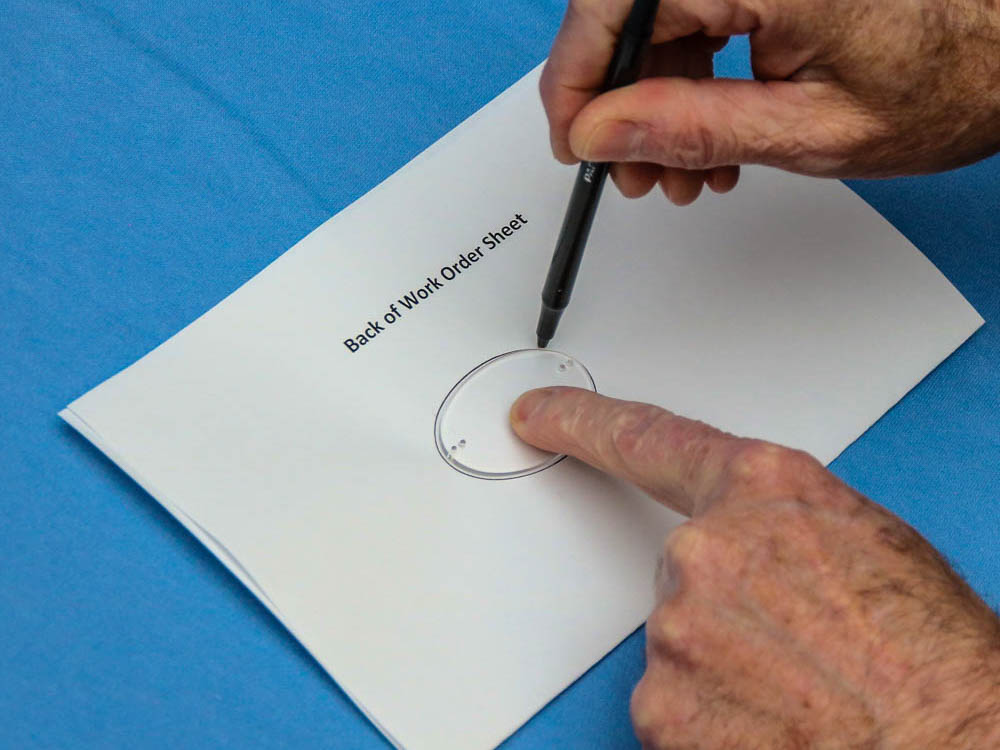
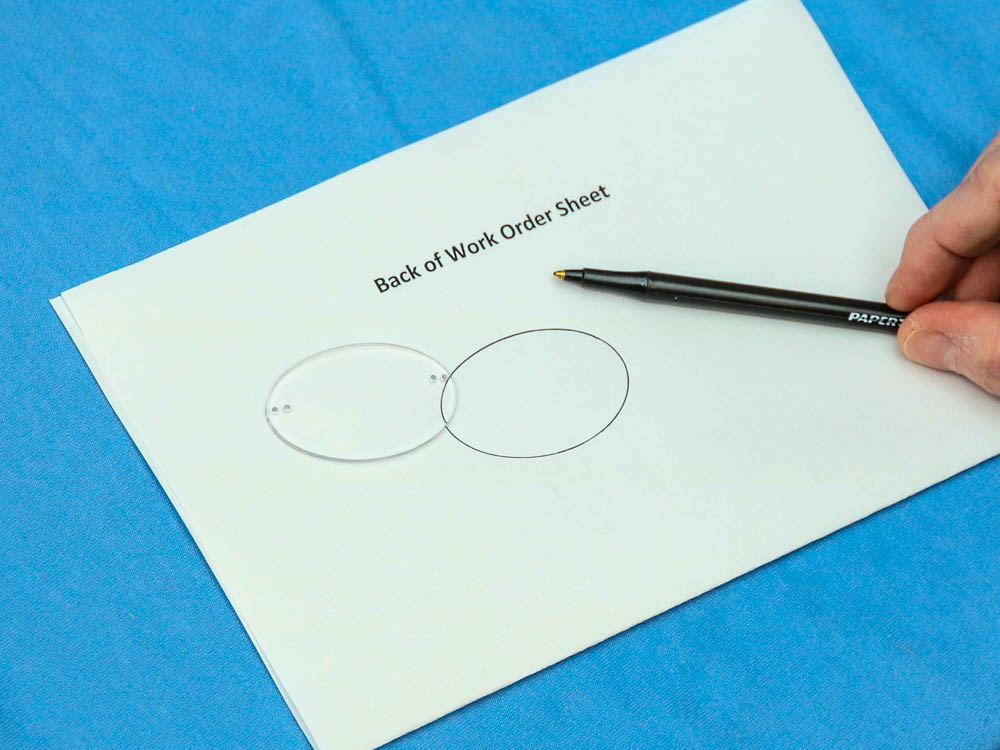
Note: For rimless jobs it is a VERY – VERY good idea to trace the desired lens shape on the back of the order form as a reference.
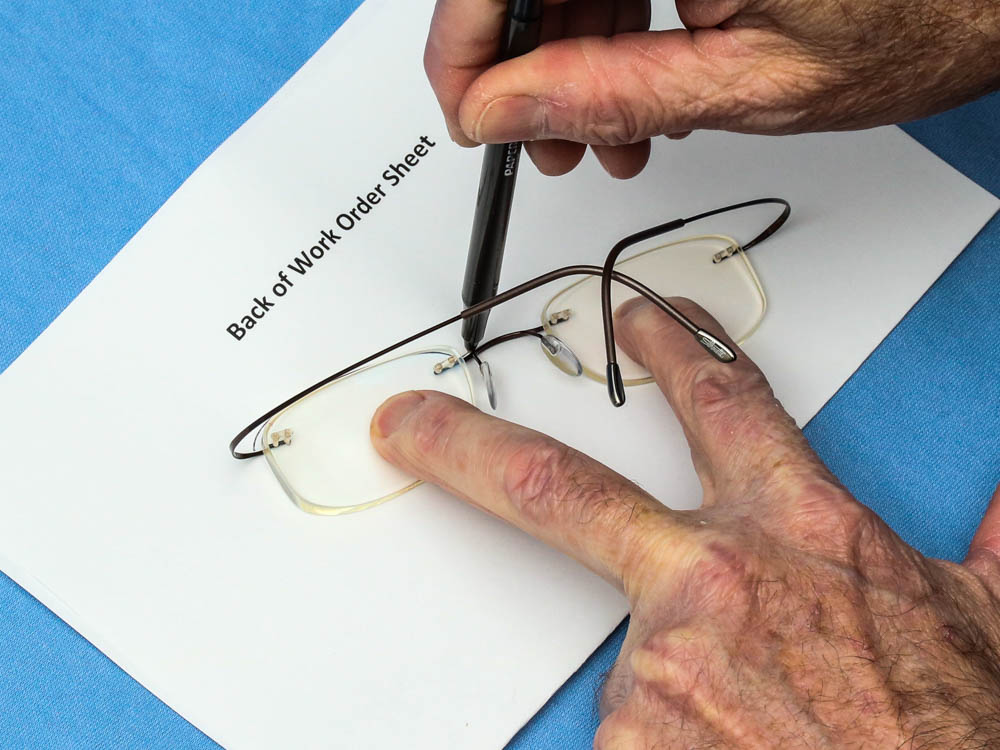
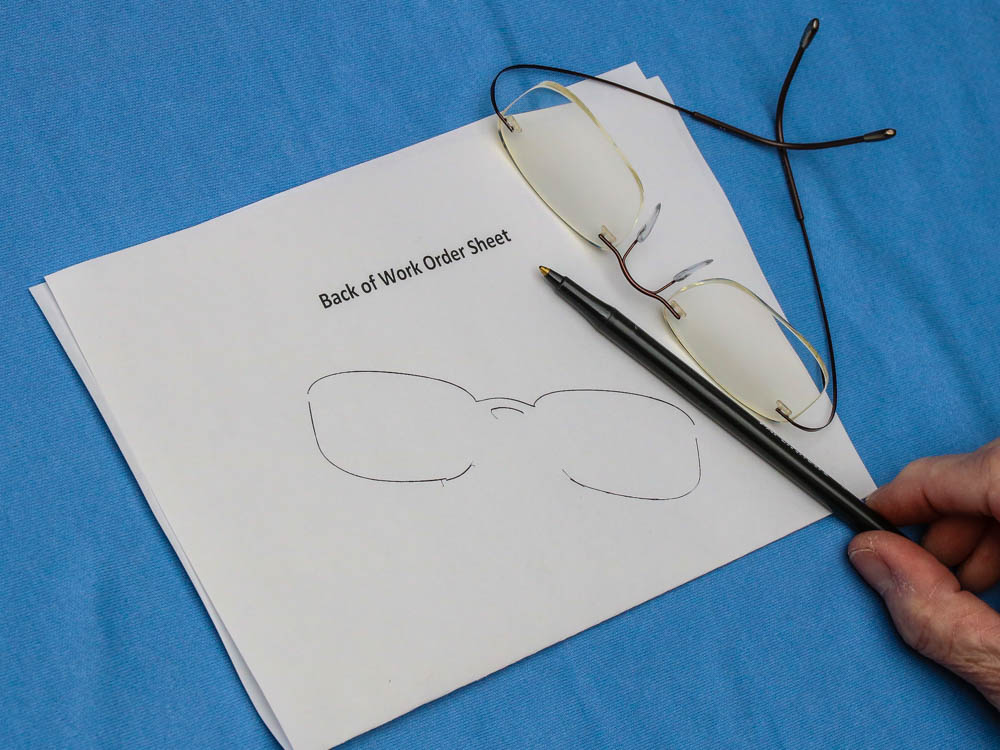
In fact, I would strongly urge you to trace the entire assembled frame and lens on the back of a job order form. This can save you in countless ways!
Once again: Don’t say I didn’t warn you!
POF (Patient’s Own Frame): Is it a customer’s own frame? This is important to know, since it will guide the way the frame will be treated in the lab. It also allows you to track the age of the frame for warranty issues and patient reuse of frame.
Frame Source: Is the frame coming from your own board and being sold directly to the patient? Is it being ordered from the frame company, then being shipped directly to the lab? Will it be provided by the lab from their stock through an insurance company? Will it be provided by the lab from their stock through an arrangement with a frame company? Will it be ordered and sent to the office for assembly?
Note: Drop – Ship means that you are having the frame sent directly from the manufacturer to the lab. Frames ordered drop – ship often require prior agreement from the frame company because they require the lab shipping information. Let us say that your patient loves the Justin Baliko 5643 but wants it in black, which you do not have, and they are in a hurry to get their glasses before leaving on vacation. You would call the frame company and “drop-ship” a JB 5643 to your lab to avoid the delay in having it shipped to your office and then on to the lab.
Lens Type: Where is the lens coming from, and in what processing state? Is it coming from store stock as a finished uncut lens? Is it coming from a lab as an uncut lens?
All lenses vary by manufacturer. Progressive lenses, in particular, come in hundreds of different designs. It is the optician’s responsibility to know the advantages and disadvantages of different lenses. You can learn the differences and the intended uses for the many progressive lenses by studying the optical trade magazines, talking with lens representatives, requesting brochures and looking through the Progressive Lens Identifier. However, if you are dealing with only one or two labs, you will only need to concern yourself with the makes and models they supply to your practice.
Lab Process: Is the lab taking care of the entire job from start to finish, or is it sending uncut lenses to you for finishing in your own in-house lab?
What Edge Does The Lens Get?: Even for finished uncut lenses, the lab needs to know what type of frame the lens will be going into. Is it a metal edge requiring a bevel? A semi-rimless requiring a smooth edge? Will they need to add thickness for a groove mount?
Special Instructions: This is an area for making special notes and special requests clear to the lab. If you rarely do a double gradient, be sure to highlight it in the special instructions section. You cannot fault a lab if it misses something you do only once a year.
Lens Material: What is the lens material? Is it plastic, hi-index 1.60, 1.66, 1.67, 1.70, 1.74, Trivex, glass or polycarbonate?
Lens Type: What style is the lens? Is it single vision, bifocal, trifocal, or progressive?
Is it a ST 25, ST 28, ST 35 or a ST 45 lined bifocal?
Is it a 7 X 28 or an 8 X 35 lined trifocal?
Is it a Laramy-K Rouge, a Zeiss Individual 2 or a Varilux Comfort 360 progressive?
Changeable Tints: You must indicate what brand of changeable tint you want the lens to have. In general, it is up to you to decide which brands of treatments you want to add to a lens. Changeable tint lenses are available only in specific styles and specific materials. Be sure to check availability before selling a specific type and material.
Lens Treatments:
Optional information to add to a lab order form:
In-House Lab Information: If your store has an edger (especially an older pattern edger), you may include a section for finishing instructions and calculations.
Pricing: Depending on your store’s methods of record keeping and bookkeeping, you may want the ability to calculate prices on your lab order form.
Lens Availability by Type and Material:
Be aware that not all lens styles are available in all lens materials. Conflicts in optics and routine supply and demand may mean many lens styles are available in only a few different materials. If in doubt, ask the lab. Become aware of which lenses are often on “back-order” when you place orders, and consider switching to a different lens. For instance, straight-top bifocals in high index materials are very expensive and very hard to get, but straight-top bifocals in basic plastic are readily available and very inexpensive.
This is another common error that creates lab delays. If in doubt about lens availability, call the lab. Do not just assume they will take care of it. You may delay a job by weeks if you fail to check lens availability first!
Lens treatments and lens types:
Different A/R coatings are provided by each of the many companies that manufacture lenses, which means that A/R coatings are both lens-specific and lab-specific. Again, using cars as examples, you can put Chevy parts on a Ford, but it takes a lot more time and effort!
Check with your lab to find out which A/R coatings are available on which lenses. For example, Essilor, a lens manufacturer, uses its own A/R coating. Zeiss, another lens manufacturer, uses its own A/R coating. Pentax, yet another lens manufacturer, uses its own A/R coating, etc.
Therefore, it is possible to order a Zeiss Gradal Top progressive with a Crizal coating, but you would have to buy the lens from a Zeiss lab, have it ground by a Zeiss lab, and have it shipped to an Essilor lab for an A/R coat. A more efficient way to accomplish the objective would be to ask Zeiss to apply its own Carat coat.
Your lab relationship is all about information and communication. You are expected to supply your lab with all the necessary information they need to run a job accurately, and the lab is expected to provide you with the status of the work in progress so you can provide your patients with accurate information about their glasses.
